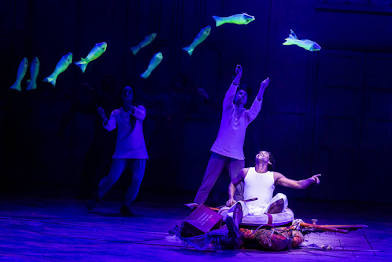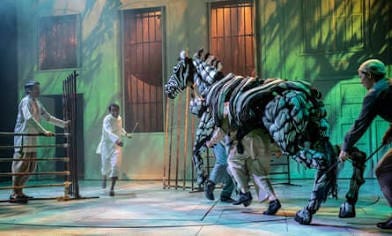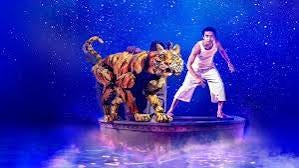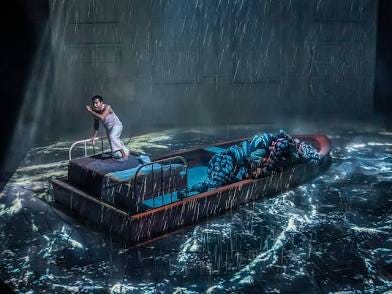Last week, my fiancée and I attended the Broadway touring production of Life of Pi at the Ahmanson Theatre. Going in, I half-expected a musical—something along the lines of singing meerkats and swelling orchestral numbers. What I experienced instead was something far more cerebral and moving: a work of theatrical poetry that’s as much about what we choose to believe as it is about survival.
The show is a marvel of stagecraft. Projections shimmered across the stage, conjuring the ocean’s wrath and serenity with hypnotic grace. The sand of the island, the distant constellations—everything was rendered with an elegant minimalism that felt almost spiritual. At one point, Pi dives into the ocean (through a hidden trapdoor, I later discovered), and the collective gasp from the audience said it all.
I was particularly struck by how symbolic the staging was. Pi’s hospital bed doubles as a lifeboat. Bits of fabric and household objects morph into stars and predators. The magic here lies in suggestion and transformation. The set doesn’t just represent the world—it becomes it, echoing the fluidity of memory, trauma, and myth.
The puppetry, too, was a wonder. Richard Parker, the tiger, is brought to life by three puppeteers who move in synchronized choreography—head, heart, and haunches. The zebra was towering, and the orangutan heartbreakingly human. I had originally wished for even larger puppet constructs, but the emotional resonance the performers conjured quickly quelled that thought. Their artistry gave soul to fabric and bamboo.
I’ve long admired the power of large-scale puppetry—from Bread and Puppet to the Little Amal movement—and I’ve written about how puppets can occupy a liminal, almost sacred space in storytelling. (I’ll link to those reflections here and here.) What Life of Pi achieves is a kind of visual liturgy: each gesture is layered with meaning, each illusion a meditation on belief.
And this, I think, is the show’s quiet genius. More than spectacle, more than survival—it is a philosophical inquiry. What do we accept as truth? What stories do we tell ourselves to make sense of suffering? Pi’s tale invites us to ask whether the tiger is real or merely a metaphor for trauma—and then gently reminds us that our answer says more about us than about the tale itself.
The sound design at the Ahmanson was as exquisite as I remember it being when I saw Phantom of the Opera there in the ‘80s and The Last Ship with Sting some years back. Clear, rich, and layered—it elevated every moment without ever distracting from the narrative.
If I have one critique, it’s of pacing. I’d trim about five minutes from each act. There were stretches that lingered just a bit too long. But that’s a minor quibble in an otherwise luminous experience.
Life of Pi is not a musical, and it doesn’t need to be. It’s a stage poem, a parable, and a provocation. It reminds us that faith—whether in God, in stories, or in ourselves—is ultimately a choice. And sometimes, choosing the better story is how we survive.
Background
Life of Pi the movie—and the stage play—are both based on the acclaimed 2001 novel Life of Pi by Canadian author Yann Martel. The book won the Man Booker Prize for Fiction in 2002 and became a global bestseller, translated into over 40 languages. Its success laid the foundation for multiple adaptations, including Ang Lee’s 2012 Oscar-winning film and the more recent stage play by Lolita Chakrabarti.
From a dramaturgical perspective, Life of Pi is rich terrain. Structurally, it is a frame narrative—a story within a story. The novel begins with a fictional version of Yann Martel interviewing an older Pi Patel, who recounts his extraordinary journey of survival. This framing device raises early questions about authorship, memory, and truth, inviting the audience to consider the reliability of storytelling.
The core of the story—Pi’s survival on a lifeboat with a Bengal tiger—is an allegorical narrative that explores themes of:
Faith and doubt (Pi practices Hinduism, Christianity, and Islam simultaneously)
The nature of reality and belief (Is the tiger story real or metaphor?)
Survival and the animalistic self (Richard Parker as both literal tiger and symbolic alter ego)
Colonial Legacy and Displacement (Pi’s migration from India to Canada parallels broader postcolonial shifts)
The book itself functions as meta-fiction—it comments on storytelling as an act of belief, a survival mechanism, and a spiritual practice. In this way, it is not just a tale of survival but a meditation on the stories we tell to endure the unendurable.
Adaptation and Dramaturgy in the Stage and Screen Versions
The film (2012) by Ang Lee embraced the surreal and mystical elements of the book through groundbreaking visual effects. Its dramaturgical choice was to render Pi's interior experience visually stunning and emotionally visceral. The film also retained the frame narrative, with the adult Pi narrating his past to a novelist.
The stage play adapted by Lolita Chakrabarti took a different route. Here, the dramaturgy centers on immediacy and embodiment. Without the luxury of CGI, the production turns to puppetry, projection, and symbolic staging to conjure the sea, the animals, and Pi’s internal transformation. The hospital setting of the play foregrounds memory, trauma, and testimony. The use of ensemble actors manipulating puppets also serves to underscore the collaborative nature of storytelling—one truth shared through many bodies.
In all its forms, Life of Pi asks the central dramaturgical question:
“Which story do you prefer?”—a line that becomes a mirror for the audience’s own beliefs about truth, fiction, and meaning.








